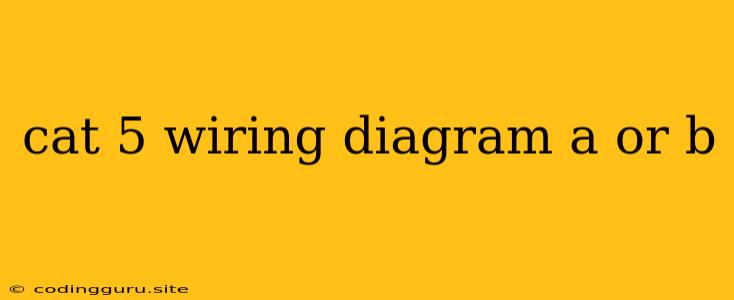Understanding Cat 5 Wiring Diagrams: A or B, Which One Matters?
When setting up a network, whether for your home or office, understanding Cat 5 wiring diagrams is crucial. The Cat 5 cable, a standard for Ethernet connections, has two common wiring configurations: Type A and Type B. While both types are functional, they use different pin assignments, which can sometimes cause confusion.
What is Cat 5 Wiring?
Cat 5 cable is a twisted-pair cable used for data transmission. It consists of eight wires, grouped into four pairs. Each pair is twisted to minimize interference, ensuring reliable data transfer. The eight wires are then assigned to specific positions within the RJ-45 connector, which is the standard connector for Cat 5 cables.
Cat 5 Wiring Diagrams: A or B
The difference between Type A and Type B lies in the way the wires are assigned to the pins of the RJ-45 connector.
Type A follows the TIA/EIA 568A standard and has the following pin assignments:
- Pin 1: Green/White
- Pin 2: Green
- Pin 3: Orange/White
- Pin 4: Blue
- Pin 5: Blue/White
- Pin 6: Orange
- Pin 7: Brown/White
- Pin 8: Brown
Type B, on the other hand, adheres to the TIA/EIA 568B standard and assigns the wires like this:
- Pin 1: Orange/White
- Pin 2: Orange
- Pin 3: Green/White
- Pin 4: Blue
- Pin 5: Blue/White
- Pin 6: Green
- Pin 7: Brown/White
- Pin 8: Brown
Do You Need to Worry About Type A or B?
The short answer is: most of the time, you don't need to worry. Both Type A and Type B wiring configurations work correctly for basic Ethernet connections. The key is to use the same configuration at both ends of the cable. If you use Type A at one end and Type B at the other, the connection will not work.
When Does it Matter?
There are some situations where the Cat 5 wiring diagram actually matters:
- Connecting to older equipment: Some older network devices might have specific requirements for Type A or Type B wiring.
- Using crossover cables: Crossover cables are used to connect two devices directly without a switch or router. They need a specific wiring scheme, usually Type A at one end and Type B at the other.
- Troubleshooting connection issues: If you're experiencing connectivity problems, checking the Cat 5 wiring diagram can help identify a potential mismatch.
Tips for Choosing the Right Cat 5 Wiring Diagram
- Consistency is key: Use the same Type A or Type B configuration at both ends of the cable.
- Check your devices: If you have older equipment, check the documentation to see if they have specific wiring requirements.
- Use online tools: There are many online tools that can help you determine the Cat 5 wiring diagram for your specific needs.
Understanding the Color Code
The colors on the Cat 5 cable can be confusing, but there's a simple way to remember them:
- White/Color: The white wire is always paired with a colored wire.
- Pairs: The colors are paired as follows: green-green/white, orange-orange/white, blue-blue/white, brown-brown/white.
Conclusion
Whether you use Type A or Type B wiring is usually not a major concern for basic network setups. However, understanding the difference is important for troubleshooting issues and configuring certain equipment.
By sticking to the same configuration on both ends and choosing the right wiring type for your needs, you can ensure reliable and fast data transmission on your network.
